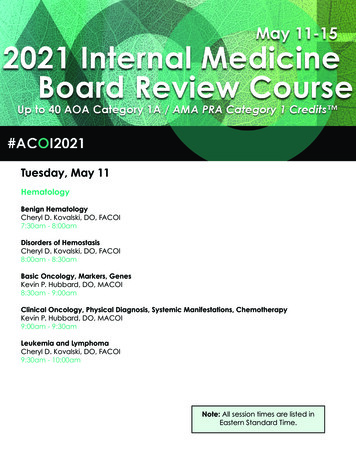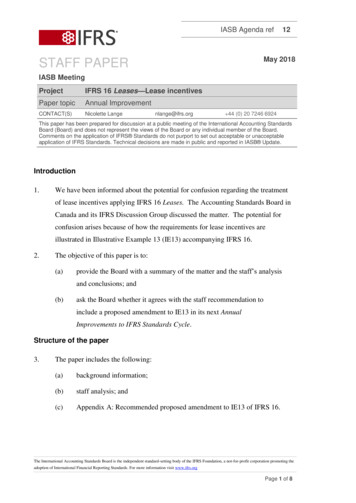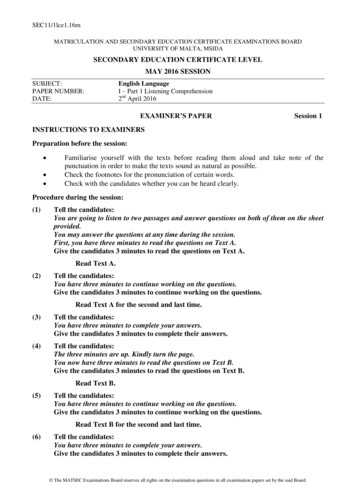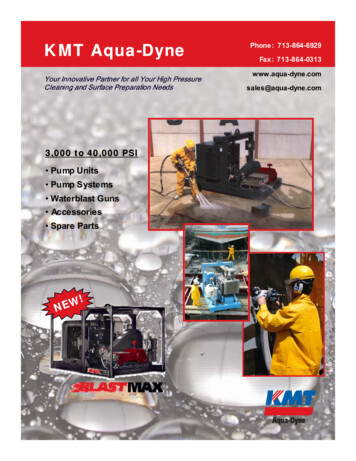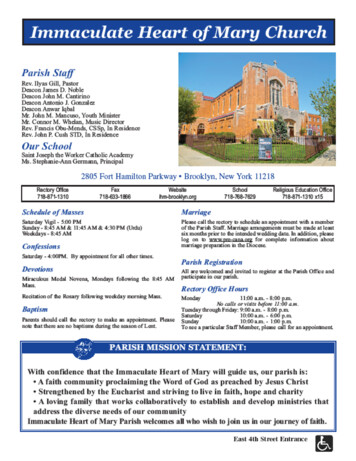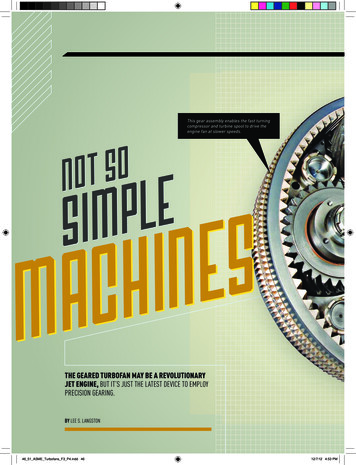
Transcription
This gear assembly enables the fast turningcompressor and turbine spool to drive theengine fan at slower speeds.OSTNOELPSIMSENIHCAMTHE GEARED TURBOFAN MAY BE A REVOLUTIONARYJET ENGINE, BUT IT’S JUST THE LATEST DEVICE TO EMPLOYPRECISION GEARING.BY LEE S. LANGSTON46 51 ASME Turbofans F3 P4.indd 4612/7/12 4:53 PM
MECHANICAL ENGINEERING JANUARY 2013 P.47Five star gears transmit power from thecentral sun gear to the outer rings.46 51 ASME Turbofans F3 P4.indd 47e live in an agethat’s dominatedby electronics—thefront page of The New York Times is aslikely as not to have an article on thelatest product from Apple or the wayteenagers are using (or misusing) theircell phones. Concept cars at variousauto shows dispense with conventionaltransmissions and the hydraulic lineshave been replaced in advanced jetplanes with fly-by-wire controls.And yet, if you flip to the secondpage of the Times, you can find thattraditional, old-fashioned machineryis still appreciated. Hardly a day goesby when small square ads for luxurytimepieces don’t appear in those pages,often without listed prices (on thetheory that if you have to ask, you reallycan’t afford one). People aren’t buyingsuch watches because they need to telltime with improved accuracy; cheapquartz watches, relying on atomic scalephenomena, are accurate to about asecond a day. Instead, the attraction isa combination of high-quality materialsand the emotional impact of precisionengineered parts—mostly gears—working together in an intricate networkto produce satisfactory results usingpurely mechanical means.Gear trains are one of the oldestknown machines, and none is moreclosely identified by the general publicwith the profession of mechanicalengineering. Gears are also integral toa new engine that has the potential tochange commercial aviation. Pratt &Whitney's geared turbofan jet enginewill have significantly better fueleconomy and much quieter operation.This new geared turbofan has a hubmounted gearing system that drivesthe front-mounted engine fan at lowerspeeds, permitting as much as 16 per-12/7/12 4:53 PM
One ancient geared mechanism predictedthe time of solar eclipses and the datesof Olympic games.cent lower fuel consumption and noisesome 15 to 20 dB lower than the latestregulations. It is scheduled for airlineoperation by 2016 on new aircraft suchas the Airbus 320neo, the new Mitsubishi regional jet, Bombardier C-Series,and the Russian Irkut MS-21.P&W has been developing this newturbofan engine since the 1980s, andits engineers are lauding the GTF as"disruptive technology." It is disruptive in the sense that it interrupts theTURBOFAN CUTAWAYnormal course of aircraft jet enginedevelopment, providing a favorablestep change in performance.“Technologies evolve,” writes economist and engineer W. Brian Arthurin his book The Nature of Technology,“based on the chaotic and constantrecombining of existing technologies."The P&W GTF combines existing jetengine technology with the well-established mechanical engineering technology of gears. And it’s not the first timePATHWAYTO EFFICIENCYMost of the air drawn in by the fan (farleft) bypasses the engine completely. Butaround 9 percent is compressed by twostages of compressor blades.The compressed air is mixed with jet fueland combusted. The exhaust is expandedthrough two sets of turbine blades (farright) which drive the engine.The gearbox, immediately behind the fan,drives the fan at a slower, more efficient speed.46 51 ASME Turbofans F3 P4.indd 4812/7/12 4:53 PM
mechanical engineering JANUARY 2013 P.49A geared turbofan engine is obscuredby instrumentation while undergoingtests at a Pratt & Whitney facility.that gears—gears from Connecticut, infact—have been involved in a disruptivetechnological break.Noted gear expert Darle Dudleytraced the art and technology of gearsas far back as 3000 BC, to Chinesetravelers crossing the Gobi Desert using two-wheeled chariots. One typeof chariot had an advanced guidancesystem: a wheel-mounted differentialgear mechanism comprising wooden pinteeth would operate an outstretched armso that it always pointed south.One of the most famous of ancient gearassemblies is the Antikythera mechanism,recovered in 1900 from a shipwreck offthe coast of Greece. Possibly constructedin Rhodes in 150-100 BC, the mechanismis an astronomical analog calculator (ororrery) that was used probably as oneof the first analog computers to predictcelestial positions of the sun and moon,the time of solar eclipses, and the datesof Olympic and Pan-Hellenic games.Although heavily corroded by its 2,000years in the sea, it has been determinedto have had at least 30 metal gears, withtriangular teeth.In more recent centuries, a decent history of the development and use of gearscould be written without losing one’sfocus on Connecticut, a U.S. state long46 51 ASME Turbofans F3 P4.indd 49known for industrial manufacturing. EliWhitney, who graduated from Connecticut's Yale College in 1765, invented thecotton gin the following year. The gin (aname probably derived from "engine")was a breakthrough machine that successfully separated cottonseed from rawcotton fibers; it used gears in many of itsmodels to transmit power to the separation mechanism. Historians point outthat the cotton gin made growing cottonvery profitable and set the plantationeconomy South on a collision coursewith the industrial North. Gears, it canbe said, set in motion the events leadingto the American Civil War.Another Yale student, Josiah WillardGibbs, was awarded the first engineering Ph.D. degree in the U.S. for his 1863thesis, "On the Form of the Teeth ofWheels in Spur Gearings." As Gibbs relates in the thesis, his work dealt with". the necessary relations between thesurfaces of the teeth of wheels, in orderthat they satisfy the various conditionsof practical utility." Gibbs went onto be a renowned American engineer,scientist, thermodynamicist, mathematician, and professor at Yale.During the 1800s and into the 1900s,Connecticut had a thriving clock andwatch industry, with names like Terry,Seth Thomas, Ingraham, Sessions,Gilbert, and Waterbury Clock (whichbecame Timex.) Clockwork gear manufacture included the early use of castbrass and wood, and later, brass stamping with an emphasis on interchangeable parts, a technology that had beenpioneered earlier by Eli Whitney withfirearm components.Connecticut companies also led inthe manufacture of machine tools suchas lathes, milling and boring machines,and screw thread machines, all ofwhich required close tolerance geartrains. As an engineering student, Iworked at one such company, the Hallden Machine Company in Thomaston.They made large flying shear machines,used to cut strip steel into sheets, as thestrip steel came off a steel plant rollingmill at many feet per second. The flyingshear moved at the speed of the stripsteel, as it cut it into sheets. Precisionelliptical gearing was used to drive andcontrol the flying shear to provide foroperation over a range of strip speedsand sheet lengths as required.In spite of all this rich history, however, it’s fair to say that no set of Connecticut gears has had to work at sucha high level of precision as those in thegeared turbofan.The first commercial jetliners werepowered by turbojets—jet engines inwhich all thrust was provided by gasesthat went through the engine from inletto exhaust nozzle, exiting in a singlehigh velocity jet. The resulting momentum increase provides the thrust forcenecessary for flight, but kinetic energyis "wasted" in the exiting jet.A more efficient design is the turbofanjet engine, so-named for a ducted fanmounted in the front. Air drawn intothe fan is divided, with some flowing12/7/12 4:54 PM
Testing has shown thatGTF gearboxes must beat least 99.3 percentefficient to avoid cookingthe lubricating oil.Thanks to its high bypass ratio, thegeared turbofan engine is 16 percentmore efficient than standard jet engines.46 51 ASME Turbofans F3 P4.indd 50out of the fan into the jet engine itselfand the remainder bypassing the engine.The lower velocity bypassed air andthe higher velocity engine air combinedownstream to produce thrust with alarger mass flow at an average velocitylower than the high velocity jet flow.With a large frontal area, the commercial aircraft turbofan is designedto produce peak thrust at takeoff, withmost of thrust produced by air drawnin by the fan and bypassing the jet engine core itself. Bypass ratios—the massof fan air bypassed for every unit massof air through the engine—currentlycan be as high as 8.4:1, as in GeneralElectric's 100,000 pound thrust GE90engine that is used on Boeing 777s.Frank Whittle, one of the inventorsof the jet engine, first proposed the addition of a fan to a jet engine in a 1930patent. He called it a thrust augmenter,because its addition does increasethrust and reduce fuel consumption(that is, it makes for lower thrust specific fuel consumption).For subsonic flight, the propulsiveefficiency, ηp of a turbofan is alsohigher than that of a turbojet. Thisefficiency is defined as the useful propulsive power (the product of thrustand flight velocity, Vo) divided by jetpower (rate of change of the kineticenergy of gases through the engine).This simplifies toηp 2 1where Ve is a suitable average ofthe lower velocity bypass air and thehigher velocity jet exhaust. That equation shows that a turbojet engine with ahigh value of Ve/Vo has a low propulsiveefficiency, while a turbofan engine withlow values has a corresponding highpropulsion efficiency. Since Ve is largely12/7/12 4:54 PM
mechanical engineering JANUARY 2013 P.51This case houses the GTF gearbox(bottom) and the low pressurecompressor inlet guide vanes (top).determined by bypass flow in a highbypass engine, the fan pressure ratio(which could by 1.6 for a bypass ratioof 8:1) is the key parameter. Loweringit to decrease Ve and increase ηp meansincreasing the bypass ratio.While driving the fan with the jetengine compressor and turbine spoolis a necessity, the two componentshave diverging needs. On the one hand,the compressor and turbine withinthe engine are most efficient at highrotational speeds. But the fan operatesmost efficiently and creates less noiseat lower rpm, and by lowering fan tipspeeds, engineers can satisfy stress andsupersonic flow limitations.The solution Pratt & Whitney engineers came up with involves separategear-connected shafts for the fan andthe compressor and turbine spool, sothat each component can run closer toits optimal operating speed. The gearedturbofan uses a fan hub-mounted epicyclic gear train. (For reference, a handcranked pencil sharpener uses epicyclicgearing.) A “sun” gear is mounted to theshaft running through the compressorand turbine. That sun gear meshes withfive surrounding intermediate gears. Acarrier, stationary with respect to the engine casing, supports the five intermediate gears which mesh with an outer ringgear attached to and driving the fan.Since the carrier is fixed, causing thefive intermediate gears to be fixed in position, they are called "star" gears, meshing with the sun gear. (If the ring gearwas fixed and the carrier was coupled tothe fan, the intermediate gears would betermed "planetary.") All five star gearshave small-diameter, high-load carryingjournal bearings, and have double helicalteeth chosen for load sharing capacityand smoother meshing action.46 51 ASME Turbofans F3 P4.indd 51Gearboxes add weight, to be sure, butthat’s compensated for by the elimination of components in the engine core.A conventional engine in the samethrust range would normally have 21 to23 stages of blading; the GTF engine,with its core operating at non-compromised fan conditions, has only 17stages. Also, the core engine parts thathave been eliminated involve high costmaterials, such as superalloys that canwithstand high temperatures, whilethe gearbox materials are less exotic,providing a potential cost benefit.Even so, it is critical that the GTFgearbox be very efficient in transmittingpower from the compressor/turbinespool to the fan. The transmitted poweris as high as 18,000 hp for the Mitsubishi engine and 30,000 hp for the Airbus320neo engine. (By convention, thegearbox power is listed in horsepower—which was James Watt's original powerunit, used to convince mine owners tobuy steam engines to replace horsesused for mine pumping.) Even smallinefficiencies such as gear tooth mismatch and bearing misalignment wouldgenerate enough heat to "cook" gearboxlubricating oil. Testing has shown thatGTF gearboxes must be at least 99.3percent efficient to avoid that problem.P&W engineers found that some 80percent of the heat load in the gearboxactually comes from churning andfoaming of the oil. Much of their designeffort has gone into getting lubricationoil quickly into and out of the unit, toprevent heat load buildup.A key facility for developing the GTFgearbox has been a specially designedfour-square gear test rig at P&W's Middletown plant. The test rig is variablespeed, with two GTF gear boxes working against each other and a torqueload applicator. Two 600 hp electricmotors provide power to operate a testand to overcome any losses in the twotest GTF gearboxes. With this test rig,P&W engineers can simulate as manyas 15,000 takeoffs in about 20 days ofcontinuous running. The orientation ofthe GTF test gearboxes can be adjustedwith respect to gravity to simulate different flight conditions.After an extensive program usingthis four-square rig and a long historyof gearbox experience associated withtheir very popular turboprop gas turbines at Pratt & Whitney Canada, P&Wengineers are convinced their new GTFengines will have a bright future.Currently, P&W's first generationgeared turbofan engines use a gearreduction of 3:1, with a resultingbypass ratio of 12:1. The resultant fuelconsumption is as much as 16 percentlower than with current conventional fan engines. Noise reduction issubstantial, with the characteristicturbofan whine
of fan air bypassed for every unit mass of air through the engine—currently can be as high as 8.4:1, as in General Electric's 100,000 pound thrust GE90 engine that is used on Boeing 777s. Frank Whittle, one of the inventors of the jet engine, first proposed the ad-dition of a fan to a jet engine in a 1930 patent. He called it a thrust .






